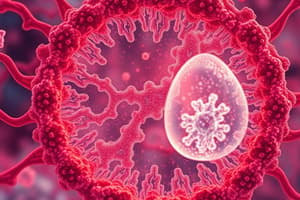Podcast
Questions and Answers
Which of the following correctly defines diploid cells?
Which of the following correctly defines diploid cells?
- Cells with pairs of homologous chromosomes (correct)
- Cells with one complete set of chromosomes from one parent
- Cells that undergo binary fission
- Cells containing one set of unpaired chromosomes
What is the role of the kinetochore during mitosis?
What is the role of the kinetochore during mitosis?
- Separates the sister chromatids
- Stabilizes the telomere
- Facilitates spindle microtubule attachment (correct)
- Duplicates the chromosomes
What is the primary event that occurs during the cell cycle?
What is the primary event that occurs during the cell cycle?
- Nuclear membrane breakdown
- Replication of DNA (correct)
- Formation of a septum
- Binary fission
What distinguishes a normal human karyotype?
What distinguishes a normal human karyotype?
During what phase does cytokinesis occur?
During what phase does cytokinesis occur?
Which phase of the cell cycle is primarily associated with DNA synthesis?
Which phase of the cell cycle is primarily associated with DNA synthesis?
During which phase of mitosis do chromosomes align at the metaphase plate?
During which phase of mitosis do chromosomes align at the metaphase plate?
What occurs during the anaphase stage of mitosis?
What occurs during the anaphase stage of mitosis?
What is the primary role of cytokinesis in cell division?
What is the primary role of cytokinesis in cell division?
In which type of cell does the absence of centrosomes during mitosis require the dependence on enzymes for spindle fiber organization?
In which type of cell does the absence of centrosomes during mitosis require the dependence on enzymes for spindle fiber organization?
Flashcards are hidden until you start studying
Study Notes
Chromosome Structure
- Chromosomes are composed of DNA and proteins
- Sister chromatids are identical copies of a chromosome, connected at the centromere
- Telomeres are protective caps at the ends of chromosomes, preventing degradation
- Kinetochores are protein structures at the centromere where spindle fibers attach
Eukaryotic Cell Cycle
- The cell cycle is a series of events leading to cell growth, DNA replication, and division
- Two main phases: Interphase and Mitotic (M) phase
- Interphase is the longest phase, divided into G1, S, and G2 phases
- G1 phase: Cell growth and normal metabolic activities
- S phase: DNA replication and duplication of chromosomes
- G2 phase: Preparation for mitosis, including protein synthesis
- M phase includes mitosis and cytokinesis
Prokaryotic Cell Cycle
- Prokaryotic cells divide by binary fission
- DNA replication, growth, and division occur without distinct phases
- No spindle apparatus or nuclear membrane involvement
- Replication occurs in the cytoplasm
Mitosis
- Division of the nucleus and cytoplasm, resulting in two genetically identical daughter cells
- Ensures the accurate distribution of chromosomes to daughter cells
- Occurs in somatic cells for growth and repair
Mitosis Stages
- Prophase: Chromosomes condense, nuclear envelope breaks down, mitotic spindle forms
- Metaphase: Chromosomes line up at the metaphase plate, attached to spindle fibers
- Anaphase: Sister chromatids separate and move towards opposite poles
- Telophase: Chromosomes reach poles, nuclear envelope reforms around each set, chromosomes decondense
- Cytokinesis: Division of the cytoplasm, forming two daughter cells
Cytokinesis in Animal and Plant Cells
- Animal Cells: Cleavage furrow forms, pinching the cell membrane inwards
- Plant Cells: Cell plate forms between the daughter nuclei, eventually becoming a new cell wall
Meiosis
- Division of the nucleus resulting in four genetically unique daughter cells, each having half the number of chromosomes as the parent cell
- Occurs in germ cells for sexual reproduction
- Involves two rounds of division: Meiosis I and Meiosis II
Meiosis I
- Prophase I: Homologous chromosomes pair up (synapsis) and exchange genetic material (crossing over)
- Metaphase I: Paired homologous chromosomes align at the metaphase plate
- Anaphase I: Homologous chromosomes separate, moving to opposite poles
- Telophase I: Two daughter cells form, each with half the number of chromosomes
Meiosis II
- Similar to mitosis, but with half the number of chromosomes
- Prophase II: Chromosomes condense, nuclear envelope breaks down, spindle fibers form
- Metaphase II: Chromosomes align at the metaphase plate
- Anaphase II: Sister chromatids separate, moving to opposite poles
- Telophase II: Four daughter cells form, each haploid (n)
Comparison of Mitosis and Meiosis
- Mitosis produces two diploid (2n) daughter cells; meiosis produces four haploid (n) daughter cells
- DNA replicates once in interphase before both mitosis and meiosis I; no replication before meiosis II
- Crossing over happens in prophase I of meiosis but not in mitosis or meiosis II
- Metaphase I of meiosis has paired homologous chromosomes aligning, whereas mitosis has individual chromosomes aligning
- Anaphase I involves the separation of homologous chromosomes, while anaphase in mitosis separates sister chromatids
Studying That Suits You
Use AI to generate personalized quizzes and flashcards to suit your learning preferences.




